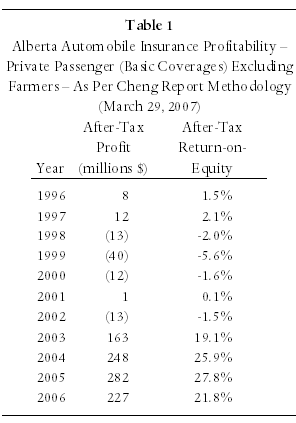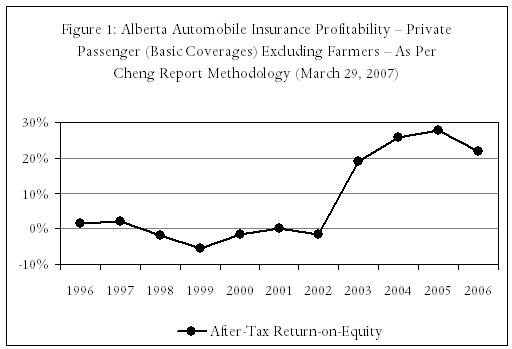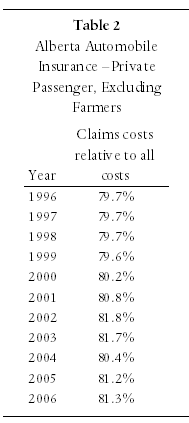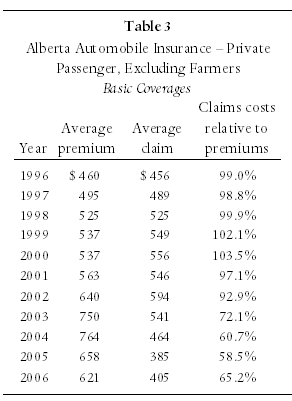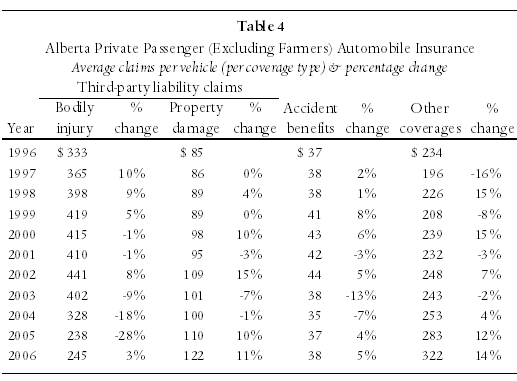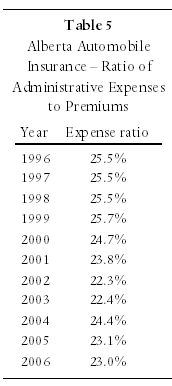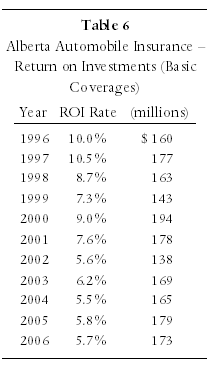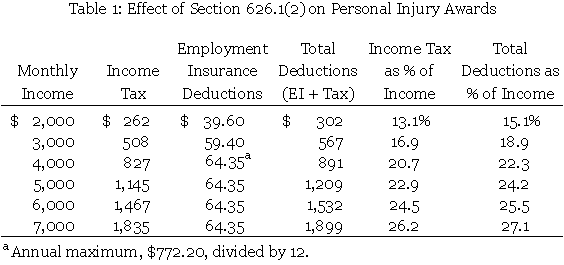This article first appeared in the summer 2009 issue of the Expert Witness.
Introduction
Between 2001 and 2003, average automobile insurance premiums for “all coverages” increased in Alberta by 33.2 percent, from $563 to $750. (See Bruce and Strauss, 2008.) In response to the public outcry that followed this increase, the Government of Alberta sought a method for constraining the growth of premiums. Accordingly, in October, 2004, it introduced the Minor Injury Regulation (MIR), which set a $4,000 limit on non-pecuniary damages for “minor” injuries.
As the MIR has been the subject of legal challenges, however, it is possible that the government may wish to consider alternative methods for reducing automobile insurance premiums. The purpose of this article is to canvass a number of techniques that have been suggested to achieve this by reducing the number and severity of accidents.
Specifically, I will survey the academic literature concerning the effects that the following policies can be expected to have on average claims costs: (i) mandatory fines for “driving under the influence” (DUI) offences; (ii) insurance surcharges following either DUI or “chargeable accident” events; (iii) increases in the minimum drinking age; (iv) a ban on driver use of cell phones; (v) mandatory use of alcolocks; and (vi) introduction of in-vehicle data recorders.
1. Mandatory DUI fines
A number of U.S. states have introduced mandatory jail terms and/or mandatory license revocation for first DUI offences. Both Sloan et. al. (1994) and Wagenaar et. al. (2007) found that these rules were associated with statistically significant reductions in numbers of fatal accidents. Nevertheless, both studies found that the absolute numbers of accidents avoided were small. The Wagenaar study, for example, found that the introduction of these mandatory measures implied that the number of individuals killed by drivers with blood alcohol content over 0.08 was approximately 13 per year per state ? a number that was worth achieving, but which would not reduce accident premiums by a significant amount.
2. Insurance surcharges for DUI and “chargeable accident” offences
Sloan et. al. (1994) also found that, among drivers over age 21, the imposition of a “substantial” premium surcharge for DUI or chargeable accidents led to fewer fatalities. The size of the surcharge, however, had to be in excess of 50 percent before it had a significant impact.
3. Raising the minimum drinking age
In 1984, the federal government in the United States began to use offers of highway funding to induce states to raise their minimum legal drinking ages (MLDA) to 21. A large number of statistical studies have been conducted to determine the effects that this policy has had on alcohol consumption among drivers in the 18 to 22 year-old age group; and on alcohol-related traffic accidents caused by drivers in these groups.
In a survey of 241 empirical analyses of MLDA that had been conducted prior to 2001, Alexander Wagenaar and Traci Toomey (2002) found that the “? preponderance of evidence?” suggested that an increase in the minimum legal drinking age was associated with a reduction in both the level of alcohol consumption among young people and the number of traffic crashes attributed to them.
Recently, Carpenter and Dobkin (2009) confirmed that MLDA laws had had a significant effect on the consumption of alcohol. 19 and 20 year-olds, for example, consumed between 11 and 21 percent less than comparable 21 year-olds. Furthermore, this reduction in consumption was associated with a 15 percent reduction in the vehicle-related mortality rate.
Similarly, Fell et. al. (2008) found that the introduction of the MLDA had resulted in an 11 percentage reduction in the ratio of drinking to non-drinking drivers aged 20 or younger who were involved in fatal car crashes. (That is, among those who were involved in fatal accidents, a smaller percentage had been drinking.) Furthermore, they also found that the most important deterrent to underage drinking was enforcement of strict rules against the use of false ID.
4. Restricting driver use of cell phones
Although it appears that most members of the public are convinced that driver use of cell phones increases the risk of accidents, it is difficult for researchers to obtain objective evidence concerning this issue.
The earliest studies, which investigated driver behaviour under laboratory conditions, found that driver reaction time was slowed when using cell phones. (McCartt, et. al. (2006).) But, as researchers were concerned that laboratory behaviour might not translate into driving behaviour under actual traffic conditions, innovative techniques were devised to draw connections between cell phone use and accident rates.
One technique, employed by Kolko (2009), was to correlate state-level data on mobile phone ownership with “hands-free” laws and traffic fatalities. He found that increased mobile phone ownership was associated with an increase in the number of traffic fatalities, “but only in bad weather or wet road conditions” (p. 21). He also found some evidence that hands-free laws reduced fatalities, but concluded that the effect was only minor.
A study conducted in Toronto (Redelmeier and Tibshirani, 1997) used a technique called case-crossover design to extract the effect of cell phone use on accident probabilities in real world applications. They obtained the cell phone records of approximately 700 drivers who had been involved in accidents that had caused “substantial” property damage, but that had not caused personal injury. Using these records, they were able to compare the degree of cell phone use of those drivers in the 10 minutes prior to the accidents with the use rates in comparable 10 minute periods on previous days.
If cell phone usage had no effect on accident activity, the researchers would have found that the same percentage of drivers were using their cell phones on the (previous) days when they did not have accidents as were using their phones on the days that they reported accidents. What Redelmeier and Tibshirani found, however, was that when drivers used a cell phone, the risk they would have an accident was approximately four times as high as when they did not use a phone. Significantly, they concluded that this risk was “?similar to the hazard associated with driving with a blood alcohol level at the legal limit.” (p. 456) They did not find, however, that the risk of an accident was lowered if drivers used a hands-free phone.
A similar, case-crossover design was subsequently used in Western Australia (McEvoy, et. al., 2005) to investigate approximately five hundred drivers who had been involved in automobile crashes that necessitated attendance at hospital. Using cell phone logs, that study confirmed the Toronto study’s finding, that drivers who had used a cell phone within ten minutes before a crash were four times more likely than non-users to have been involved in a serious crash.
In a Vancouver study (Wilson, et. al., 2003), observers stationed at street corners determined whether drivers were using cell phones. If they were, their license plate numbers were recorded, thus allowing researchers to compare cell phone use with Insurance Corporation of British Columbia records concerning automobile insurance claims. It was found that those drivers who had been observed to be using cell phones were significantly more likely than the average driver to have made at least one “at-fault” crash claim in a previous four year period. This finding was much stronger for female drivers than for male.
All of these studies shared the problem that there had been no direct observation of the drivers at the time that the accident occurred. To resolve this issue, the U.S. National Highway Traffic Safety Administration (NHTSA) fitted approximately one hundred cars with both video cameras ? to record both the driver’s actions and the events on the road immediately around the vehicle ? and electronic sensors ? to measure such aspects of the automobile’s actions as speed, acceleration, deceleration, and sudden turns.
The in-car video recorders were able to monitor the drivers’ cell phone use and the degree of their attentiveness to the road. The remaining video recorders could record traffic conditions; while the electronic recorders could measure the driver’s responses to external events.
After observing each car for more than a year, researchers were able to conclude that the actions of (i) dialing a hand-held device and (ii) talking/listening to a hand-held device each contributed to 3.6 percent of all crashes and near-crashes. (NHTSA, 2006: p. 32) The sum of these two figures, 7.2 percent, is approximately equal to one third of the effect of driving while moderately or severely drowsy.
5. Alcolocks
The Swedish government has been experimenting with the use of “alcolocks” to reduce driving while intoxicated (DWI). These are instruments that lock a car’s ignition until the driver has blown into an alcohol-measuring device, (and recorded an alcohol level below the maximum permissible). In one experiment, Swedish drivers who had been convicted of DWI were enrolled in an alcohol ignition interlock programme (AIIP) for two years. Bjerre and Thorsson (2008) found that participants in the AIIP were more likely than non-participants to qualify for full reinstatement of their drivers’ licenses at the end of the two-year period; and that they were less likely to be in traffic accidents or to be charged with DWI offences after that period.
Alcolocks could be used to reduce traffic accidents in Alberta in two ways. First, they could be employed in a manner similar to that in Sweden, to assist in the rehabilitation of drivers who had been charged with DWI. Second, they could be employed by drivers who had been charged with DWI offences and who wished to obtain reduced insurance rates by providing evidence to their insurers that they were not driving while intoxicated.
6. In-vehicle data recorders
Computer systems in automobiles have advanced to the point that it is now a relatively simple matter to monitor and record not only engine performance but also driver performance. At a low cost, for example, in-vehicle data recorders (IVDRs, sometimes called event data recorders, EDRs), can keep records of actions associated with increased probabilities of accidents, such as rapid changes in acceleration or deceleration, sudden changes in direction, average speed, distance travelled, and time of day travelled. (See Bordoff and Noel, 2008, at p. 13, for a discussion of current IVDR technology.)
With the addition of a GPS system, information can also be obtained concerning the speed limits, road conditions (for example, ice or snow), weather, and traffic congestion in the areas travelled by the driver; and with the addition of an alcolock, information can also be provided about the driver’s blood alcohol content.
A number of insurance companies ? particularly Progressive and GMAC Insurance in the United States (McQueen, 2008) and, to a lesser extent, Aviva in Canada (Bordoff and Noel, 2008) ? have recognized that even IVDRs that lack GPS systems can be used to reduce automobile insurance premiums in two ways.
First, it will be possible to identify, and reward (with reduced premiums), those individuals who: are less likely than average to be involved in accidents because they drive relatively few kilometers, are unlikely to engage in risky behaviour (as measured by acceleration, deceleration, and sudden turns), drive at speeds at which few serious accidents occur, and drive at times of day that are associated with low accident frequency.
Second, and more importantly, the data from IVDRs could be used to induce drivers to reduce the probability they would become involved in accidents, either by reducing the distance they drove or by increasing the level of precautions they took. Drivers could either volunteer to reduce their risk exposure ? for example, by reducing the number of kilometers driven or decreasing the number of incidents of sudden acceleration or deceleration, as measured by the IVDR ? in return for reduced insurance premiums; or they could agree to pay increments in premiums based on increased risk, again as measured by the IVDR.
One variation on this possibility would be to disband the “Facility Association,” (the program that allows high risk drivers to obtain insurance at actuarially unfair rates), and to replace it with a program based on the use of IVDRs. That is, high risk drivers could be offered the opportunity to moderate their premiums if they would agree to reduce their accident-causing behaviour, as measured by IVDRs installed in their vehicles. (Note: drivers would not be “forced” to install IVDRs: they would be given the choice between paying actuarially fair premiums or providing evidence that their behaviour had changed in such a way as to justify lower premiums.)
Even when a GPS is not attached to the IVDR, research shows that the information that can be extracted from an IVDR is sufficient to induce changes in driver behaviour. In a thorough review of the evidence, for example, Jason Bordoff and Pascal Noel (2008), of the Brookings Institution, argued that the introduction of a system in which individual drivers’ automobile insurance premiums were directly correlated with numbers of miles driven (pay-as-you-drive insurance) would reduce the number of automobile accidents by eight percent.
Toledo et. al. (2008) found that the risk data collected by the IVDRs in their experiment were strongly correlated with the probability that drivers had been involved in at-fault accidents. Interestingly, they also found that even when drivers were told that the information from IVDRs would not be used to reward or punish them, crash rates declined by approximately 19 percent. The presence of the IVDR alone was sufficient to alter driver behaviour.
The primary concern with IVDRs that has been expressed in the literature (see, especially, Askland, 2006), is that they represent an invasion of the driver’s privacy. Two responses have been made to this criticism. First, if a GPS system is not attached to the IVDR, the data that can be collected ? average speed, distance driven, number of occasions of sudden acceleration or deceleration, etc. ? provide no more information about the individual than do the data already collected by the car’s odometer and engine monitoring system.
Second, as long as the individual is free to choose whether to install an IVDR and whether to provide the information stored in any such system to a third party, that information is no more invasive of the individual’s privacy than are questions that consumers already voluntarily respond to when seeking health or life insurance or consumer credit.
7. Conclusion
In the early 2000s, automobile insurance premiums rose dramatically in Alberta, Ontario, New Brunswick, Nova Scotia, and Prince Edward Island. In each of these provinces, the government responded by reducing the benefits that were available to drivers ? that is, by introducing a limit on the non-pecuniary damages that were available to plaintiffs who had suffered “minor” injuries.
In this article, I have argued that numerous alternative policies exist that could reduce premiums, not by reducing benefits, but by reducing the incidence and severity of automobile accidents. Some of these policies ? such as IVDRs and alcolocks ? are still under development, and others ? such as raising the minimum drinking age or banning cell phone use ? may be politically unacceptable. Nevertheless, a strong argument can be made, I believe, for presenting the evidence concerning these policies to the citizens of Alberta, to determine whether they consider the potential savings to outweigh the costs.
References
Askland, A. (2006) “The Double Edged Sword that is the Event Data Recorder,” 25 (1) Temple Journal of Science Technology, and Environmental Law, 1-14
Bjerre, B., and J. Kostela (2008) “Primary Prevention of Drink Driving by the Large-Scale Use of Alcolocks in Commercial Vehicles,” 40 Accident Analysis and Prevention, 1294-1299.
Bjerre, B., and U. Thorsson (2008) “Is an Alcohol Ignition Interlock Programme a Useful Tool for Changing the Alcohol and Driving Habits of Drink-Drivers?” 40 Accident Analysis and Prevention, 267-273.
Bordoff, J., and P. Noel (2008) Pay-As-You-Drive Auto Insurance: A Simple Way to Reduce Driving-Related Harms and Increase Equity, The Hamilton Project: Brookings Institution, (July).
Bruce, C., and J. Strauss (2008) “Premiums, Profits, and Costs of Business in Alberta’s Automobile Insurance Industry, 1996-2006,” 13(2) Expert Witness, 2-7.
Carpenter, C., and C. Dobkin (2009) “The Effect of Alcohol Consumption on Mortality: Regression Discontinuity Evidence from the Minimum Drinking Age,” 1(1) American Economic Journal of Applied Economics, 164-182.
Fell, et. al. (2008) “The Relationship of Underage Drinking Laws to Reductions in Drinking Drivers in Fatal Crashes in the United States,” 40 (4) Accident Analysis and Prevention, 1430-1440.
Kolko, J. (2009) “The Effects of Mobile Phones and Hands-Free Laws on Traffic Fatalities,” 9 (1) B.E. Journal of Economic Analysis and Policy.
McCartt, A., et. al. (2006) “Cell Phones and Driving: Review of Research,” 7 Traffic Injury Prevention, 89-106.
McEvoy, S., et. al. (2005) “Role of Mobile Phones in Motor Vehicle Accidents Resulting in Hospital Attendance: A Case-Crossover Study,” British Medical Journal.
McQueen, M. (2008) “How Technology Can Help Trim Auto Insurance,” Wall Street Journal, June 26; accessed on May 8, 2009 at http://online.wsj.com/article/SB121443810954605365.html.
NHTSA (2006) The Impact of Driver Inattention on Near-Crash Risk, DOT HS 810 594.
Redelmeier, D., and R. Tibshirani (1997) “Association Between Cellular-Telephone Calls and Motor Vehicle Collisions,” 336 (7) New England Journal of Medicine, 453-458.
Sloan, F., B. Reilly, and C. Schenzler (1994) “Tort Liability versus Other Approaches for Deterring Careless Driving,” 14 (1) International Review of Law and Economics, 53-72.
Toledo, T., O. Musicant, and T. Lotan (2008) “In-Vehicle Data Recorders for Monitoring and Feedback on Drivers’ Behavior,” 16 Transportation Research, Part C, 320-331.
Wagenaar, A., and T. Toomey (2002) “Effects of Minimum Drinking Age Laws: Review and Analyses of the Literature from 1960 to 2000,” Journal of Studies on Alcohol, Supplement No. 14, 206-225.
Wagenaar, A., et. al. (2007) “General Deterrence Effects of U. S. Statutory DUI Fine and Jail Penalties: Long-term Follow-Up in 32 States,” 39 (5) Accident Analysis and Prevention, 982-994.
Wilson, J., M. Fang, and S. Wiggins (2003) “Collision and Violation Involvement of Drivers Who Use Cellular Phones,” 4 Traffic Injury Prevention, 45-52.
![]()
